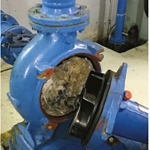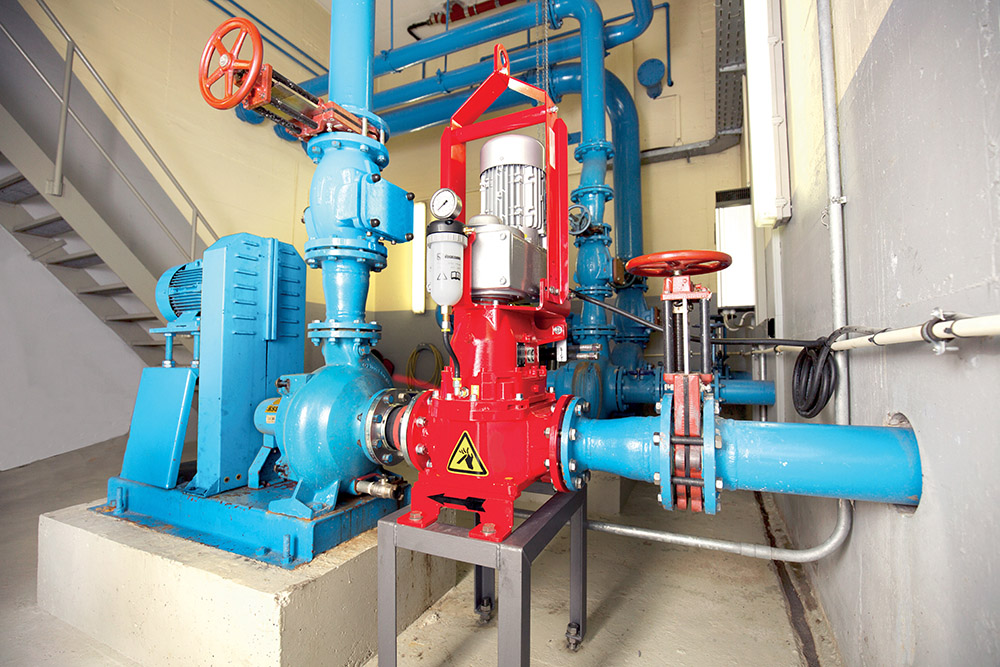People’s bad habits of flushing wet wipes and other unwanted items down the toilet, are causing more and more problems for waste water treatment companies. Clogged pumps and other equipment are becoming a common occurrence, and eliminating these problems is time consuming and costly. The good news is that these malfunctions can be cost effectively avoided by installing twin-shaft grinders, as three case studies demonstrate…
Today’s systems for dealing with wastewater have to meet a diverse range of requirements. Many plants achieve high reliability by maximizing the effectiveness of their pumps. Operators have to be equipped to handle storm conditions. In addition the transportation of waste water needs to be energy and resource efficient. The pumps operate for relatively long periods of time, so their efficiency is extremely important.
Alongside these complex factors, plant operators are faced with fundamental challenges. The public’s habits with dealing with waste are changing. For a long time wet wipes were reserved for child care. Today, they are a feature of everyday hygiene and often end up in the toilet after use. Tampons, panty liners, and sanitary napkins are also being flushed down the toilet, with few consumers being aware that it goes totally against the advice from their waste water treatment authority. Textiles too, especially clothing, find their way into sewer systems.
Once they get into the sewer system, they become a problem for all the downstream equipment. Due to the fibres they contain, wet wipes do not disintegrate nearly as easily as toilet paper. Instead they form knots and gradually clog pumps and pipes. Even centrifugal pumps with a cutting device – so-called shredder pumps – are pushed beyond their limits. In pump stations and sewage treatment plants, removing the blockages has become part of the weekly routine, burdening waste water treatment plant staff with increasing costs for maintenance work.
Twin-shaft grinders installed upstream of pumps are increasingly emerging as a solution for this problems. These devices offer protection for the pumps by shredding coarse solid matter, overcoming disruption to operations. Today’s advanced twin-shaft grinders use comparatively little power, and their low speeds provide high torque for cutting when needed. Precision machined monolithic shredding rotors allow high forces to be applied, making the cutting teeth powerful and efficient. At the same time wear resistant components mean further reductions in operating costs.
As space is usually at a premium, twin-shaft grinders are available in various compact designs, to allow installation even in very tight spaces. Optimised designs permit high flow rates and ensure a small footprint. In addition to configurations similar to dry well pump installations, there are compact inline options for space efficient retrofitting, and designs for intake structures and open sewers. Stainless steel versions are also available, as well as submersible motors.
Wet wipes don’t stand a chance
The local authority association of Wonnegau in Germany comprises the town of Osthofen and ten smaller villages. Part of the area’s wastewater is conveyed to a sewage treatment plant at Worms by a pumping station in Osthofen. Around 8,000 inhabitants are connected to it, as well as three retirement homes, three kindergartens, and there is an industrial estate.
Dry well pumps are used in the pumping station to pump the wastewater up to street level. It then flows to the Worms sewage treatment plant by gravity. The pumping station has three centrifugal pumps for sewage and four additional pumps for combined sewage and stormwater.
The smallest of the centrifugal pumps handles the bulk of the sewage, with a pumping capacity of 30 litres per second (approximately 108 m3/h). The pump has a 5.5 kW drive motor running on average for about 20 hours a day, with brief interruptions, depending on the amount of incoming water.

Wet clumps, clogged pumps
Sanitary products, especially wet wipes, repeatedly disrupted the operation of the main pump. It had to be opened an average of once or twice a week to remove clogging. This maintenance work required two employees to remove about 50 litres of knotted material from the pump and associated pipework, which took them over all two hours.
For long term elimination of problems caused by wipes and other coarse matter, the local authority association installed a twin shaft grinder. The device had to meet three requirements: Maintenance and part replacement had to be able to be performed by the association’s own personnel. Independent control was essential, in order to limit changes to the existing control. Additionally the tight spaces in the pumping station meant that the device had to match the specific installation situation, so as to allow direct service and maintenance in the space available.
An exact fit for tight spaces
The XRipper XRP from Vogelsang installed at the end of 2015 can be serviced directly on site by the own staff, who require few tools and no intensive training to do so. The drive unit can be lifted up out of the housing by a chain hoist, together with the shafts and shredding tools, for maintenance or servicing work. Parts like the XRipper rotors, seals, and gaskets are easily accessible and therefore quick to replace.
Because the motor is mounted above the device, it has a small footprint, making it suitable for installation in very cramped conditions as in the pumping station in Osthofen. The grinder could be integrated easily into the existing pipework as an inline installation, requiring minimal structural work. Control of the XRipper twin-shaft grinder is provided by an accompanying control cabinet. Only minimal modifications were required to the existing control equipment.
Goodbye blockages: An investment that pays off
The grinder reduces coarse matter contained in the wastewater, such as wet wipes and sanitary products, to a manageable size. The grinder thus eliminates the strain on the waste water pump and prevents blockage induced failures and service interruptions.
“Since going into operation at the start of January 2016, the pump and the XRipper have been running smoothly. There’s no more clogging at the pump,” said plant supervisor Heiko Schuch. Since installation of the twin shaft grinder, it has ensured ongoing operation of the main sewage pump without interruptions. What’s more the intervention has paid off. The extra electricity consumed by the XRipper is countered by a reduction in the power consumption of the centrifugal pump. And thanks to the trouble free operation of the pump, the association saves more than 200 hours of work for maintenance every year.
Clothing and trash versus pumps
The environment agency in Osan in South Korea operates the local sewage treatment plant and monitors the sewer system. The waste water generated by a local village is collected in a tank and pumped to a basin situated higher up from where it then flows to the sewage treatment plant by gravity. Three submersible pumps are installed in the pumping station to do this job. Together they achieve a delivery rate of 200 m3/h.
In order to prevent interruptions and malfunctions as a result of textiles, wood and plastic, twin-shaft grinder produced by a Korean manufacturer were installed. However, their performance proved disappointing and the environment agency started looking for an alternative solution.
They opted for the XRipper XRP186-260Q. Due to its compact design, it could be installed without any problems. Comparing it directly with the second competitive machine still installed, the customer could immediately see the advantages gained by the Vogelsang grinder. The XRipper is quieter and can easily manage greater volumes of wastewater … and the QuickService design of the XRipper XRP allows quick and direct servicing by their own onsite staff.
Reliable protection at reduced costs
Kelda Water Services Grampian – Kelda Water Services (KWS) have a 28 year contract to design, build, operate and maintain a number of wastewater treatment sites in the North East of Scotland. The Nigg waste water treatment site in Aberdeen serves a population of approximately 250,000 people.
KWS Grampian installed twin shaft grinders at the inlet works of the Nigg site a number of years ago, in order to protect downsteam equipment and to improve the efficiency of the screening. Whilst they were happy with the general function of the twin shaft grinders, the ongoing cost of ownership was a growing concern. These grinders did not allow for easy maintenance and could not be serviced by their own engineers, resulting in frequent overhauls carried out off site and creating expensive and time consuming repairs.
“When we spoke to Vogelsang, it became clear that they had an alternative design that could help us dramatically reduce our maintenance costs. The Vogelsang XRipper is end user serviceable, enabling us to have the unit maintained on site by our own in house engineers and back in service within a few hours. The monolithic rippers on the XRipper are not only easier to change than the traditional separate blades and spacers, they also give added robustness to the assembly meaning a reduction in the frequency of maintenance down time” explains Noel Gallagher.
A Simpler Alternative
With a large number of Vogelsang rotary lobe pumps already installed on the Nigg site, KWS engineers were familiar with the easy to service nature of Vogelsang products. When the XRipper concept was presented, they were keen to install the XRipper XRC186-520QD SIK on a comparative trial. After 12 months of operation, the Vogelsang XRipper has already demonstrated a 60% maintenance cost reduction against the previously installed units.
In summary: Changing disposal habits are creating new challenges for wastewater technology. Many municipalities and authorities are finding raised amount of maintenance work that the personnel need to undertake, to meet these challenges…and frequent maintenance interventions also mean sharp increases in costs. Manufacturers of wastewater technology have developed solutions in the form of twin shaft grinders which provide an economical way of avoiding these problems. The design of these devices is such that they can be retrofitted in existing installations with relative ease. By working closely with manufacturers, operators are finding an efficient, purpose built way of avoiding malfunctions in pumps for the long term.
vogelsang.co.uk



